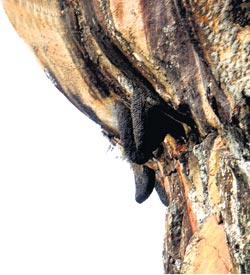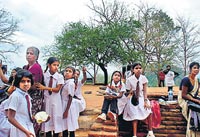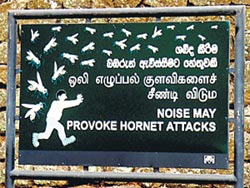
Sigiriya’s stingersThe Sri Dalada Maligawa, one of the country’s most sacred sites venerated by millions of Buddhists was attacked by LTTE suicide bombers in 1998. Recently, another of Sri Lanka’s famed world heritage sites faced a suicide attack of sorts. Thousands of suicide warriors attacked visitors at Sigiriya, sacrificing their lives to repulse a potential threat to their ‘castle’; the honeybee colonies hanging on the magnificent rock face. The most recent attack on August 2 happened at around 10.30 a.m. when the bees disturbed by the sounds of a group of schoolchildren, took wing and stung those in their path. Students and visitors panicked and several were injured in the stampede down the steps. Over 70 were admitted to the Sigiriya hospital for treatment. A few had to be transferred to the Dambulla hospital for further treatment.
The bee sting while painful and dangerous to the victim, results in the death of the bee. The wild bee’s sting is on its rear attached to a venom sac. The barbed sting lodges in the flesh of the victim upon use, tearing free from the bee’s body along with the last abdominal segments. The bee dies within a few minutes from the loss of blood and body fluid through the open wound. The stinger has its own mechanism to continue sawing into the victim’s flesh, releasing venom for several minutes. The sting is accompanied by the release of alarm pheromones. The smell of these pheromones signals the other bees and they continue to swamp the victim. What causes the bee attack? Do they purposely attack humans? Shouldn’t the colonies be removed from Sigiriya? These were some of the questions that arose following last week’s incident. Bees, wasps or hornets? “Beware of Hornets” read the warning signs on the Rock. “Wasps sting visitors in Sigiriya” was how the incident was reported in some newspapers. So are these bees or wasps or hornets? “They are a species of bees. Wasps are carnivorous insects that build a different kind of nest and are known as debara in Sinhala. Technically speaking, the hornet is a larger species of wasp. Those who nest at Sigiriya are Giant Honeybees or Rock Bees that are scientifically classified as Apis dorsata,” explains Dr. R.W.K. Punchihewa, an expert on bees in Sigiriya. “In Sinhala we call them bambara. It is of course bigger than the Oriental Honeybee Apis cerana, which is domesticated and cultured for beekeeping. Giant Honeybees prefer to nest in exposed areas, usually on tree limbs or under cliff overhangs, and sometimes on buildings.
Each colony consists of a single vertical comb suspended from above, and the comb is typically covered by a dense mass of bees. They do not use enclosed cavities like the Oriental Honeybees. This may be one reason for their aggressive defensive behaviour,” says Dr. Punchihewa. Colony defence Colony defence is a duty of the worker bees. About three-quarters of the worker population of a colony is engaged in colony defence. They cover the hive forming a protective curtain. Guard bees recognize members of their own colony by a hive odour specific to each colony. Having the same odour, returning foragers have no difficulty in passing through the hive entrance, but most foreign intruders, including worker bees from other colonies with a different odour, are repelled by the guards. If a threat is sensed, the guard bees exhibit a warning posture, and this signal is transmitted to nearby workers who also adopt the same posture. This creates a wave that travels across the hive with an audible threatening sound. It is a warning that has been issued to the unsuspecting person or animal that you are too close to the comb. “Warrior Bees”, probably the best documentary about the bees of Sigiriya done by the National Geographic captured this unique threatening posture. Bee colonies Legend has it that the Wild Bees in Sigiriya are the incarnation of the soldiers of King Kashyapa. Thus they are here to protect the site and their presence keeps visitors in check. Dr. Punchihewa has observed around 30-40 nests on the Sigiriya rock during his study and says the majority of the bee colonies, are concentrated near the Lion’s Paw in the wind hide. Bees are not present in Sigiriya all through the year. They are a migratory species and go on a journey towards the hill country that coincides with the seasonal flowering of some plants such as Nelu. Bees arrive in the Sigiriya area usually around January-February and start moving further south from July. Bees attack only when provoked. Usually in Sigiriya, it is the misbehaviour of visitors that causes bee attacks. There were instances where schoolchildren sometimes threw stones. It is important not to disturb them by shouting. “It can be extremely dangerous if the colony is provoked,” Dr. Punchihewa says. Common occurrence “Bee stings are a common occurrence in this area. One or two patients get treatment from Sigiriya hospital for bee stings daily . It is a common thing in these remote villages where people need to go into the jungle for various needs,” commented Dr. Ruwan Subasinghe of the Sigiriya Hospital, which is some four km from the Rock. “Most of the patients this time were schoolchildren. There were about 60-70 who got stung. We treated them mainly with antihistamines like Piriton,” he added.
Bee venom contains melittin, a histamine that is painful for many hours. When stung, the area will swell and the itching may sometimes continue for weeks. There is an allergic reaction which can be fatal to some, if adequate medical treatment is not given. “The rumour that seven of these wild bees contain venom similar to a cobra is not true. What is critical is how the body reacts to the venom. Even one bee sting may be serious for some, while we have seen those who are stung more than 50 times and still survive. The attack can lead to shock which causes low blood pressure and difficulties in breathing which can ultimately lead to a cardiac arrest,” said Dr. Kithsiri Ranasinghe of the Dambulla hospital who has treated many victims. In case of an attack? In case of a bee attack, the key is not to panic! A large percentage of those who are admitted to the hospital suffered from injuries caused by falls. If you are stung, the sting should be removed as quickly as possible to avoid venom being injected. When removing the sting, you should be careful not to squeeze the venom gland, as it will make the injection of the venom faster, Dr. Subasinghe advised. Should the beehives be removed? The bees have to be identified as a part of the legacy of Sigiriya. Wild Bees in Sigiriya are long-time dwellers of the rock. Removing them from Sigiriya might not be a difficult task, but should not be attempted, says Dr. Punchihewa. They are usually peaceful if not disturbed. If the visitors respect them, they will not attack, he adds. Dr. Punchihewa recommends planting trees that may provide alternative options for bees to build their nests. It is known that Giant Honeybees prefer certain larger trees and these can be planted in the vicinity to attract them. It is also important to have adequate bee shelters, so that visitors can retreat to these enclosures until the bees settle down in the event of an attack. There are shelters on the Rock, but these are said to be used for other purposes and visitors could not make use of them during last week’s attack. The Bee is a keystone species. Conservation efforts in Sri Lanka usually focus on protecting larger animals, but while the ecosystems can survive without elephants or leopards, the whole cycle will collapse, if such a keystone species as the bees who perform the important function of pollinating flowers, is removed. |
|| Front
Page | News | Editorial | Columns | Sports | Plus | Financial
Times | International | Mirror | TV
Times | Funday
Times || |
| |
Copyright
2007 Wijeya
Newspapers Ltd.Colombo. Sri Lanka. |


